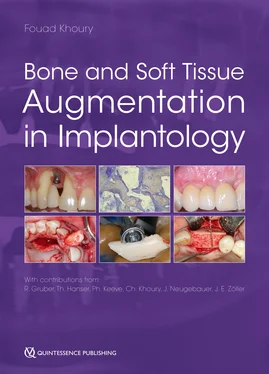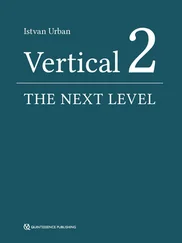Nowadays, a large number of antibody therapies are successfully used for cancer treatment, even in the advanced stages, and are sometimes administered continually to avoid cancer progression. This can significantly improve the survival rates of these patients. Although these therapies are not without side effects, there are fewer compared with conventional chemotherapy. Therapies include the administration of high-dose cortisone, which is utilized to stabilize the patient. However, even in cases where such treatments are given only for a short period of time, they can negatively influence the prognosis of treated teeth as well as the healing of bone postsurgery due to their intervention in the calcium balance. Therefore, tooth loss that is due to tumor treatment, bone metabolism, and the capacity for wound healing should be clarified specifically, as is the case with patients undergoing antiresorptive therapy. 10
2.3.2.3 Albert Schoenberg’s disease
This hereditary osteopathy, known as marble bone disease, shows a massive compression of cancellous bone and medullary spaces of the regular bone tissue caused by a genetic defect of the osteoclast function. Strong bone apposition without sufficiently simultaneous bone resorption compresses the medullary spaces so severely that hardly any vascularization remains possible. The bone then looks extremely white, like marble. Radiologically, the eponymous marble-like change in bone structure is also known as osteopetrosis. It also shows developmental disorders of the teeth, with enamel hypoplasia and crown and root malformations. High-grade sclerosis results in an increased risk of fracture of the entire skeleton, with a poor healing tendency of the bone, so that implant or augmentation therapy is absolutely contraindicated. 65With this condition, single case reports show a high risk of osteomyelitis after implant placement. 61
2.3.2.4 Osteitis deformans (Paget’s disease)
This is a chronic generalized or monostotic bone disorder of an unknown cause that occurs predominantly in the 6th and 7th decade of life in males. In contrast to Albert Schoenberg’s disease, the cortical bone is transformed into a fine-meshed cancellous bone, the medullary spaces of which are filled with fibrous tissue. 15
In addition to the rheumatic complaints, an increase in the circumference of the skull is characteristic, which in extreme cases presents as Leontiasis ossea (lion face) with a high skull cap, pronounced prominent zygomatic bones, increased eye relief, and distension of the maxilla. Radiologically, brightening and shading occur, resembling a cotton flake structure, and the affected bone is generally thickened. Nowadays, the bisphosphonates described above are usually administered intravenously to stabilize the bone. Due to the altered bone metabolism, a strict indication for implant or augmentation therapy is recommended. The initial case reports show positive treatment outcomes, although there are as yet no long-term studies. 75,76,90If necessary, modeling osteotomies can be performed to improve the prosthetic anchorage on the deformed alveolar process.
Today, many people self-medicate to improve their physical and psychologic wellbeing. These medications are often not declared at the anamnesis, even though they may have an impact on the outcome of implant therapy. How these medications impact implant therapy has not yet been evaluated for all medications, and many patients assume that their medication history is not relevant for the dentist. Patients receiving proton pump inhibitors (PPI) to treat gastritis or serotonin reuptake inhibitors to stabilize depression episodes exhibit higher rates of implant failure. 45In these patients, the duration and number of drugs should be investigated before considering implant treatment. 45
For other medications such as glucocorticoids and NSAIDs, conflicting results have been reported regarding their effect on implant treatment outcomes. 26However, due to the risk of serve wound healing disturbances, the possibility of a drug holiday should be checked with the responsible physician regarding long-term or high-dose glucocorticoid treatment.
Table 2-1ASA physical status classification system (last approved by the ASA House of Delegates on 15 October 2014) 40
| ASA PS classification |
Definition |
Examples (including, but not limited to) |
| ASA I |
A normal healthy patient |
Healthy, non-smoking, no or minimal alcohol use |
| ASA II |
A patient with mild systemic disease |
Mild diseases only, without substantive functional limitations. Examples include (but are not limited to): current smoker, social drinker of alcohol, pregnancy, obesity, well- controlled DM/HTN, mild lung disease |
| ASA III |
A patient with severe systemic disease |
Substantive functional limitation; one or more moderate to severe diseases. Examples include (but are not limited to): poorly controlled DM or HTN, COPD, morbid obesity (BMI ≥ 40), active hepatitis, alcohol dependence or abuse, implanted pacemaker, moderate reduction of ejection fraction, ESRD undergoing regularly scheduled dialysis, premature infant PCA < 60 weeks, history (> 3 months) of MI, CVA, TIA or CAD/stents |
| ASA IV |
A patient with severe systemic disease that is a constant threat to life |
Examples include (but are not limited to): recent (< 3 months) MI, CVA, TIA, or CAD/stents, ongoing cardiac ischemia or severe valve dysfunction, severe reduction of ejection fraction, sepsis, DIC, ARD or ESRD not undergoing regularly scheduled dialysis |
| ASA V |
A moribund patient who is not expected to survive without the operation |
Examples include (but are not limited to): ruptured abdominal/thoracic aneurysm, massive trauma, intracranial bleed with mass effect, ischemic bowel in the face of significant cardiac pathology or multiple organ/system dysfunction |
| ASA VI |
A declared brain-dead patient whose organs are being removed for donor purposes |
|
2.3.2.6 Cardiovascular diseases
Other general medical conditions only represent a contraindication to implant and augmentation therapy if the patient’s life is threatened by the surgical procedure. Intraoperative cardiovascular complications induced by surgical stress should be reduced or even eliminated by perioperative monitoring. 13Depending on their medical insurance system, it is recommended for patients with ASA Class III to receive dentoalveolar treatments as inpatient procedures ( Table 2-1). 47If surgical intervention is performed as an outpatient procedure, it must be ensured that postoperative home care is in place. In an infarct event, there is an absolute contraindication for elective implant prosthetic surgery in the first 6 months.
2.3.2.7 Hemorrhagic diathesis
When anticoagulant therapy is required, the risk of extensive intraoperative or postoperative bleeding is relevant ( Fig 2-6). Anticoagulant therapies are not an absolute contraindication; however, depending on the indication, the risk of a suspended medication or changeover should be weighed against the associated benefits of planned implant and augmentation therapy. 82When patients declare that they are taking one or more of the so-called blood thinners, it is crucial to find out the exact medication. In case of postoperative bleeding, it is important to know the exact mechanism and, if appropriate, to take into account the specific systemic treatment for the drug ( Table 2-2). In some diseases such as atrial fibrillation and coronary artery stenting, double or even triple anticoagulant therapy is recommended. 78
Читать дальше












